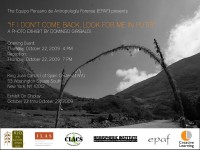AdvocacyNet November 6, 2009, Lima, Peru: In a striking example of community-based advocacy, a survivor of Peru’s “dirty war” against terrorism has won election as the first mayor of Putis, a village in southern Peru that suffered one of the country’s worst-ever massacres.
Gerardo Fernandez was elected by acclaim this summer after villagers in the Putis area collected the 1,000 signatures required to establish a new Centro Poblado (community). The designation opens the way for Putis to demand government services and even press for reparations on behalf of those who were killed. Mr Fernandez, who recently visited Washington to meet with the US State Department and Senate, lost a son, daughter, and mother during Peru’s 20-year struggle against the Shining Path. His election represents a victory not just for human rights but for Peru’s indigenous people, who were targeted by the Army and guerrillas but had little recourse because of their exclusion from the mainstream of Peruvian life. Over 15,000 Peruvians are thought to have disappeared between 1980 and 2000. Ninety-two died on December 13, 1984, when soldiers attacked the village of Putis. It was not until the spring of 2008 that their remains were exhumed by the Peruvian Forensic Anthropology Team (EPAF) and restored to their families. The Advocacy Project (AP), a partner of EPAF, attended the Putis exhumation and helped EPAF publicize the event through blogs and video. Three AP volunteers (Peace Fellows) have since helped EPAF develop information tools to promote its work. In the process, EPAF has also empowered the relatives of those who died. After hiding out in the jungle for several years Mr Fernandez returned to Putis and formed an association of relatives to lobby for justice. During a video interview last year with AP at the Putis gravesite, he said that his advocacy had received a major boost from the exhumation.
430 villagers from Putis were killed or disappeared out of a total population of 1,700, he said: “We ask that the rest of the mass graves in the area are exhumed, and that those responsible are brought to justice. (We also seek) individual and collective reparations.” Following the exhumation, Mr Fernandez went on to seek election. Last month, he brought his cause to Washington where he met with staffers from the office of Senator Patrick Leahy and the Open Society Institute. Mr Mendoza also briefed officials at the Bureau of Democracy, Human Rights and Labor in the US State Department, which funded the Putis exhumation. It was Mr Fernandez’s first trip outside Peru and Jose Pablo Baraybar, the director of EPAF, who accompanied him, was impressed by his poise and persistence. “It shows the power of memory,” said Mr Baraybar. “The relatives are saying ‘We haven’t gone away. We still exist.’” Mr Fernandez’s visit to Washington was also the latest move by EPAF to ensure that the disappearances in Peru remain on the international agenda. Gisela Ortiz, another EPAF official, will visit Washington next week to meet with the Inter-American Commission of Human Rights. Ms Ortiz’s brother was kidnapped and killed by a death squad in 1992. Although the violence has left a deep and traumatic legacy in villages like Putis, the government of Peru is hardening its position against any full-scale accounting. On October 14, a special human rights chamber of Peru’s Supreme Court acquitted several army commanders from the military base of Los Laureles, in the north, who may have been implicated in killings. Alan Garcia, the President of Peru, has proposed that a special committee be set up to review all cases that involve the military. The chief prosecutor has opposed the move. Meanwhile, experts warn that by trying to ignore the past, the government may be risking a new confrontation with a resurgent Shining Path, which appears to be recruiting young men at gunpoint to carry drugs. A column from the Shining Path passed through the EPAF encampment last year, highlighting the security risks that face human rights work in isolated areas of Peru. The AP video on Putis massacre: http://www.advocacynet.org/page/putisfilm EPAFR video: http://epafperu.org/ Ash video interview with Gisela Ortiz; http://www.youtube.com/watch?v=kEtVUSh3LTI&feature=player_embedded#at=176





 06 nov 2009
06 nov 2009
 Posted by epafperu
Posted by epafperu 







